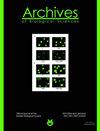超氧化物歧化酶2、谷胱甘肽过氧化物酶1、着色性干皮病d组基因变异与头颈部鳞状细胞癌易感性的关系
IF 0.8
4区 生物学
Q4 BIOLOGY
引用次数: 0
摘要
氧化应激与头颈部鳞状细胞癌(HNSCC)的发病机制有关,抗氧化酶系统和DNA修复蛋白的功能在癌症的发展中起着关键作用。为了研究抗氧化超氧化物歧化酶2 (SOD2) Val16Ala、谷胱甘肽过氧化物酶1 (GPX1) Pro198Leu和DNA修复色素干皮病D组(XPD) Lys751Gln基因在吸烟和饮酒等外源性危险因素下的遗传多态性在HNSCC癌变中的作用,我们对139例无关病例和265例非癌症对照进行了病例对照研究。分析了加性遗传、显性遗传和隐性遗传、个体遗传和互作遗传的多态性。SOD2的T等位基因携带者与男性和吸烟者罹患HNSCC的风险增加有关;同样,GPX1的T等位基因与整体和吸烟亚组的风险升高有关。GPX1 TT、SOD2 CT和XPD CC基因型携带者患HNSCC的风险增加12.47倍。这是首次研究SOD2, GPX1和XPD多态性在三种遗传模式下相互作用在HNSCC发展中的潜在作用。结果表明,这些多态性单独轻微地改变了HNSCC发展的风险,但当它们一起发挥作用并进行评估时,它们的风险明显更高。本文章由计算机程序翻译,如有差异,请以英文原文为准。
Association between superoxide dismutase 2, glutathione peroxidase 1, xeroderma pigmentosum group d gene variations, and head and neck squamous cell cancer susceptibility
As oxidative stress is implicated in the pathogenesis of head and neck squamous cell cancer (HNSCC), the functions of antioxidant enzyme systems and DNA repair proteins are critical in the development of cancer. To investigate the role of genetic polymorphisms of the antioxidant superoxide dismutase 2 (SOD2) Val16Ala, glutathione peroxidase 1 (GPX1) Pro198Leu, and the DNA repair Xeroderma Pigmentosum Group D (XPD) Lys751Gln genes under exogenous risk factors, including smoking and alcohol consumption, in HNSCC carcinogenesis, we conducted a case-control study on 139 unrelated cases and 265 non-cancer controls. Polymorphisms were analyzed in additive, dominant and recessive genetic models, individually and in an interaction model. Carriers of the T allele of SOD2 were associated with an increased risk for HNSCC in the overall subgroups of males and smokers; similarly, the T allele of GPX1 was associated with elevated risk in the overall and smoker subgroup. A 12.47-fold increased risk was observed for the carriers of GPX1 TT, SOD2 CT and XPD CC genotypes for HNSCC. This is the first study presenting the potential roles of SOD2, GPX1 and XPD polymorphisms in interaction and under three genetic models in the development of HNSCC. The results suggest that these polymorphisms slightly modify the risk in HNSCC development individually but are significantly higher when they functioned and were evaluated together.
求助全文
通过发布文献求助,成功后即可免费获取论文全文。
去求助
来源期刊
CiteScore
1.40
自引率
0.00%
发文量
25
审稿时长
3-8 weeks
期刊介绍:
The Archives of Biological Sciences is a multidisciplinary journal that covers original research in a wide range of subjects in life science, including biology, ecology, human biology and biomedical research.
The Archives of Biological Sciences features articles in genetics, botany and zoology (including higher and lower terrestrial and aquatic plants and animals, prokaryote biology, algology, mycology, entomology, etc.); biological systematics; evolution; biochemistry, molecular and cell biology, including all aspects of normal cell functioning, from embryonic to differentiated tissues and in different pathological states; physiology, including chronobiology, thermal biology, cryobiology; radiobiology; neurobiology; immunology, including human immunology; human biology, including the biological basis of specific human pathologies and disease management.

 求助内容:
求助内容: 应助结果提醒方式:
应助结果提醒方式:


